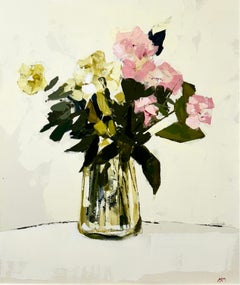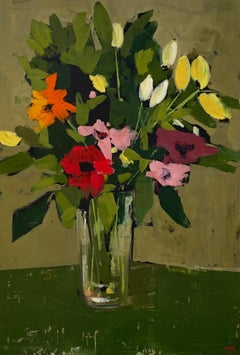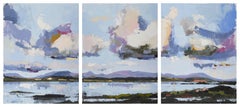Martin Mooney Art
Irish, b. 1960
Regarded as one of Ireland’s most accomplished fine art painters, Martin Mooney was born in 1960, in Belfast, Northern Ireland. Mooney graduated from the Brighton College of Art & Design and the prestigious Slade School of Fine Art, where he completed his Masters in Fine Art painting. Mooney’s outstanding technical ability, together with his keenness to look to the past for inspiration, has gained him appreciation over the years from a number of admirers including his tutors at Slade, Euan Uglow and Sir Lawrence Gowing. He also gained attention from the London Evening Standard’s art critic Brian Sewell who had written an essay, in 1990 for Mooney’s first solo exhibition at Dublin’s Solomon Gallery and spoke glowingly of this ‘fine painter with a natural intelligence’ who had taken up the mantle of the past. Since his first solo exhibition, Mooney has had numerous sell-out exhibitions in Dublin, London, Toronto and New York.
Mooney has been known to build up his paintings using glazed layers, often bathed in a golden hue. Whether his paintings are set in Dublin or Venice, Gerona or Donegal they all have a similarity. He paints architecture, countryside and still life using enriched tones, rich reds and pale blues.
In an exhibition in 2007, at the James Adam Auctioneers in Dublin, Mooney gave a new desire to paint floral still life and landscapes of Donegal. He wanted to challenge himself as an artist and create new subject matters, which led him to be an even more accomplished painter.
Now based in rural Donegal, Mooney’s landscapes are informed by his absorption of plein air painting. His billowing cloud formations and insertions of unexpected colour epitomise Mooney’s new relationship with colour and form, along with a new sense of fluidity and freedom.
1960 Born Belfast, Northern Ireland. 1979-80 University of Ulster, Faculty of Art and Design
1980-83 Brighton Polytechnic College of Art and Design; BA Honours Fine Art
1983-85 University College London, The Slade School of Fine Art (Post Graduate)
Awards include: 1983 Emily Lucy Boyce Travel Scholarship, Brighton Faculty of Art
1985 Richard Ford Award, The Royal Academy, London
1987 George Campbell Memorial Grant, Arts Council of Ireland, Arts of Northern Ireland and the Spanish Cultural Institute, Dublin
1992 Adams Salesrooms Choice of Artist for Future Appreciation Award, Royal Hibernian Academy, Dublin
1997 Completed ten large paintings for the Merrion Hotel, Dublin
2001 Appointed official artist for HRH The Prince of Wales Royal Tour of the Baltic States
2003 Appointed official artist for HRH The Prince of Wales Royal Tour of Russia
2017 Completed commission of 12 paintings for a house in Merrion Square.
Works in private collections in Ireland, United Kingdom, France, Guernsey, Spain, The Netherlands, Switzerland, USA, Canada, South Africa, Morocco, Australia and Hong Kong.(Biography provided by Gormleys Gallery)
to
5
5
4
1
1
2
2
Overall Height
to
Overall Width
to
3
2
3
2
1
1
1
1
1
5
5
6,856
3,182
2,516
1,217
5
5
2
Artist: Martin Mooney
Flowers on White
By Martin Mooney
Located in Belfast, GB
Flowers on White
Oil on Board
61 x 50.8 cm
24 x 20 in
Regarded as one of Ireland’s most accomplished fine art painters, Martin Mooney was born in 1960, in Belfast, Northern Ireland....
Category
2010s Old Masters Martin Mooney Art
Materials
Oil
Connemara, Near Roundstone
By Martin Mooney
Located in Belfast, GB
Connemara, Near Roundstone
Oil on Board
36 x 38 in
91.4 x 96.5 cm
Regarded as one of Ireland’s most accomplished fine art painters, Martin Mooney was born in 1960, in Belfast, North...
Category
2010s Old Masters Martin Mooney Art
Materials
Oil
Tree Study I
By Martin Mooney
Located in Belfast, GB
Tree Study I
Oil on Panel
152.4 x 121.9 cm
Regarded as one of Ireland’s most accomplished fine art painters, Martin Mooney was born in 1960, in Belfast, Northern Ireland.
Mooney gr...
Category
2010s Contemporary Martin Mooney Art
Materials
Oil
Autumn Flowers
By Martin Mooney
Located in Belfast, GB
This is an oil on panel painting in Martin Mooney's signature frame.
Regarded as one of Ireland’s most accomplished fine art painters, Martin Mooney was born in 1960, in Belfast, No...
Category
2010s Contemporary Martin Mooney Art
Materials
Oil, Panel
Spring Flowers
By Martin Mooney
Located in Belfast, GB
This is an oil on panel painting in Martin Mooney's signature frame.
Regarded as one of Ireland’s most accomplished fine art painters, Martin Mooney was born in 1960, in Belfast, No...
Category
2010s Contemporary Martin Mooney Art
Materials
Oil, Panel
Related Items
18th century portrait of a Spaniel dog with fruit in a wooded landscape.
By Tobias Stranover
Located in Woodbury, CT
Outstanding early 18th-century portrait of a seated Spaniel dog in a landscape with an array of fruits.
Attributed to the work of Tobias Stranover.
...
Category
1730s Old Masters Martin Mooney Art
Materials
Oil
Free Shipping
H 24.5 in W 34.5 in
Florals in classic urn Old Masters 17th century Dutch style
Located in Hillsborough, NC
Floral with Urn is in a classical Dutch style that dates to the 17th century. The bright flowers drape the urn in whites, crimsons and pinks, standing out against the darker foliage...
Category
17th Century Old Masters Martin Mooney Art
Materials
Canvas, Oil
Still Life of Fruit - Dutch 17th century art Old Master still life oil painting
By Jan Davidsz. de Heem
Located in London, GB
This stunning Dutch 17th century Old Master still life oil painting is attributed to the circle of Jan Davidsz de Heem. Painted circa 1660 it is a magnificent vibrant painting of gra...
Category
17th Century Old Masters Martin Mooney Art
Materials
Oil
Still Life of Flowers in Ornamental Urn on Ledge - Dutch Old Master oil painting
By Gerard van Spaendonck
Located in London, GB
This superb vibrant Dutch 18th century Old Master floral oil painting is attributed to circle of Gerard Van Spaendonck. Painted circa 1790, it is a beautiful mixed floral still life flower arrangement in an ornate urn on a marble ledge against a landscape. The flowers include roses, tulips, blue iris and trailing blue morning glory. The carved ornate grey/blue urn on the cream marble ledge create a strong textural contrast with the soft petals and leaves. This is a wonderful example of Dutch 18th century floral oil paintings with fine detail and brushwork.
Provenance. Private Collection, UK (by descent).
Condition. Oil on canvas, 30 inches by 25 inches unframed and in good condition.
Frame. Housed in an ebonised frame, 39 by 34 inches framed and in good condition.
Gerard van Spaendonck (1746-1822) was a Dutch painter. Gerard was born in Tilburg, an older brother of Cornelis van Spaendonck...
Category
1790s Old Masters Martin Mooney Art
Materials
Oil
Still Life with Squash, Gourds, Stoneware, and a Basket with Fruit and Cheese
Located in New York, NY
Provenance:
Selma Herringman, New York, ca. 1955-2013; thence by descent to:
Private Collection, New York, 2013-2020
This seventeenth century Spanish still-life of a laden table, known as a bodegón, stands out for its dramatic lighting and for the detailed description of each object. The artist’s confident use of chiaroscuro enables the sliced-open squash in the left foreground to appear as if emerging out of the darkness and projecting towards the viewer. The light source emanates from the upper left, illuminating the array, and its strength is made apparent by the reflections on the pitcher, pot, and the fruit in the basket. Visible brush strokes accentuate the vegetables’ rough surfaces and delicate interiors. Although the painter of this striking work remains unknown, it is a characteristic example of the pioneering Spanish still-lifes of the baroque period, which brought inanimate objects alive on canvas.
In our painting, the knife and the large yellow squash boldly protrude off the table. Balancing objects on the edge of a table was a clever way for still-life painters to emphasize the three-dimensionality of the objects depicted, as well a way to lend a sense of drama to an otherwise static image. The knife here teeters on the edge, appearing as if it might fall off the table and out of the painting at any moment. The shape and consistency of the squash at left is brilliantly conveyed through the light brush strokes that define the vegetable’s fleshy and feathery interior. The smaller gourds—gathered together in a pile—are shrouded partly in darkness and stand out for their rugged, bumpy exterior. The stoneware has a brassy glaze, and the earthy tones of the vessels are carefully modulated by their interaction with the light and shadow that falls across them. The artist has cleverly arranged the still-life in a V-shaped composition, with a triangular slice of cheese standing upright, serving as its pinnacle.
Independent still-lifes only became an important pictorial genre in the first years of the seventeenth century. In Italy, and particularly through the revolutionary works of Caravaggio, painted objects became carriers of meaning, and their depiction and arrangement the province of serious artistic scrutiny. Caravaggio famously asserted that it was equally difficult to paint a still-life as it was to paint figures, and the elevation of this new art form would have profound consequences to the present day. In Spain Juan Sanchez Cotan...
Category
17th Century Old Masters Martin Mooney Art
Materials
Canvas, Oil
A Wolf
Located in New York, NY
Provenance:
The Marchesi Strozzi, Palazzo Strozzi, Florence
Sale, Christie’s, London, May 20, 1993, lot 315, as by Carl Borromaus Andreas Ruthart...
Category
17th Century Old Masters Martin Mooney Art
Materials
Canvas, Paper, Oil
Early oil depicting the Great Fire of London
Located in London, GB
The Great Fire of London in September 1666 was one of the greatest disasters in the city’s history. The City, with its wooden houses crowded together in narrow streets, was a natural fire risk, and predictions that London would burn down became a shocking reality. The fire began in a bakery in Pudding Lane, an area near the Thames teeming with warehouses and shops full of flammable materials, such as timber, oil, coal, pitch and turpentine. Inevitably the fire spread rapidly from this area into the City. Our painting depicts the impact of the fire on those who were caught in it and creates a very dramatic impression of what the fire was like. Closer inspection reveals a scene of chaos and panic with people running out of the gates. It shows Cripplegate in the north of the City, with St Giles without Cripplegate to its left, in flames (on the site of the present day Barbican). The painting probably represents the fire on the night of Tuesday 4 September, when four-fifths of the City was burning at once, including St Paul's Cathedral. Old St Paul’s can be seen to the right of the canvas, the medieval church with its thick stone walls, was considered a place of safety, but the building was covered in wooden scaffolding as it was in the midst of being restored by the then little known architect, Christopher Wren and caught fire. Our painting seems to depict a specific moment on the Tuesday night when the lead on St Paul’s caught fire and, as the diarist John Evelyn described: ‘the stones of Paul’s flew like grenades, the melting lead running down the streets in a stream and the very pavements glowing with the firey redness, so as no horse, nor man, was able to tread on them.’
Although the loss of life was minimal, some accounts record only sixteen perished, the magnitude of the property loss was shocking – some four hundred and thirty acres, about eighty per cent of the City proper was destroyed, including over thirteen thousand houses, eighty-nine churches, and fifty-two Guild Halls. Thousands were homeless and financially ruined. The Great Fire, and the subsequent fire of 1676, which destroyed over six hundred houses south of the Thames, changed the appearance of London forever. The one constructive outcome of the Great Fire was that the plague, which had devastated the population of London since 1665, diminished greatly, due to the mass death of the plague-carrying rats in the blaze.
The fire was widely reported in eyewitness accounts, newspapers, letters and diaries. Samuel Pepys recorded climbing the steeple of Barking Church from which he viewed the destroyed City: ‘the saddest sight of desolation that I ever saw.’ There was an official enquiry into the causes of the fire, petitions to the King and Lord Mayor to rebuild, new legislation and building Acts. Naturally, the fire became a dramatic and extremely popular subject for painters and engravers. A group of works relatively closely related to the present picture have been traditionally ascribed to Jan Griffier...
Category
17th Century Old Masters Martin Mooney Art
Materials
Oil, Canvas
A Pair of Forest Landscapes, Philipp H. Brinckmann, 1709 – 1761, Old Master
Located in Bruges, BE
A Pair of Forest Landscapes with River and Boat in the Foreground
Brinckmann Philipp Hieronymus
Spire 1709 – 1761 Manheim
Old Master
Signature: Signed "Ph. Brinckm" bottom lower lef...
Category
18th Century Old Masters Martin Mooney Art
Materials
Copper
H 13.78 in W 16.54 in D 1.58 in
A park
Located in Genève, GE
Work on cardboard
Plaster and gilded wood frame
46 x 55.5 x 5 cm
Category
Mid-19th Century Old Masters Martin Mooney Art
Materials
Oil
The Misunderstanding - Still Life with Honey Bee on Edge of Crystal Decanter
By Matthew Cook
Located in Chicago, IL
While still life painting can be dated back to the Ancient Egyptians, this still life takes on a modern theme. A crystal decanter and whiskey glass are set upon a piece of fraying tapestry. The curiosity comes when the viewer takes a closer look to discover a bee has flown in and is perched precariously on the neck of the decanter. This piece is framed in a heavy wooden frame with a gold insert. The framed dimensions are H 14.5 x W 16.5 inches.
Matthew Cook...
Category
2010s Old Masters Martin Mooney Art
Materials
Oil, Panel
Shepherd with Sheep, Cows and a Goat in a Landscape by Jan Frans Soolmaker
Located in Stockholm, SE
Jan Frans Soolmaker (Flanders 1635‑1685)
Shepherd with Sheep, Cows and a Goat in a Landscape
oil on relined canvas
canvas size 56 x 53 cm
frame i...
Category
17th Century Old Masters Martin Mooney Art
Materials
Oil, Canvas
Free Shipping
H 22.05 in W 20.87 in
Painting 18th Century Vanitas Still Life Skull Religion Esotericism Occult
Located in Saint-Ouen, FR
Vanitas 18th century
French School
Oil on canvas
Old frame gilded with gold leaves
Dim canvas : 73 X 60 cm
Dim frame : 93 X 80 cm
Certificate of authenticity
Category
Late 18th Century Old Masters Martin Mooney Art
Materials
Oil
H 36.62 in W 31.5 in D 3.94 in
Previously Available Items
Cashel Connemara- Triptych
By Martin Mooney
Located in Belfast, GB
This is a triptych, a series of three paintings depicting Cashel in Connemara which is on the West coast of Ireland. The artwork is an oil paint on panel.
Regarded as one of Ireland...
Category
2010s Contemporary Martin Mooney Art
Materials
Panel, Oil
Martin Mooney art for sale on 1stDibs.
Find a wide variety of authentic Martin Mooney available for sale on 1stDibs. You can also browse by medium to find art by Martin Mooney in oil paint, paint, panel and more. Much of the original work by this artist or collective was created during the 21st century and contemporary and is mostly associated with the contemporary style. Not every interior allows for large Martin Mooney, so small editions measuring 24 inches across are available. Customers who are interested in this artist might also find the work of John Brooks, Steve Smulka, and Patty Neal. Martin Mooney prices can differ depending upon medium, time period and other attributes. On 1stDibs, the price for these items starts at $13,350 and tops out at $27,256, while the average work can sell for $27,256.







